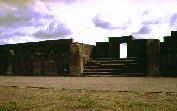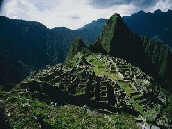1400 - 400 BC: The first settlement
 Wandering tribes, supposedly proceeding from the Bering Strait,
became sedentary and began living by gathering, fishing and hunting
Wandering tribes, supposedly proceeding from the Bering Strait,
became sedentary and began living by gathering, fishing and hunting
- Harvesting of quinoa and potatoes,
- Domestication of llamas, alpacas and vicunas.
During this period, several cultures developed (e.g. the Wankarani and Chiripa) and subsequently disappeared, having transmitted their knowledge to new civilizations. On the altiplano, only one civilization had continued its development: the Tiwanaku civilization.
400 BC - 900 AD: The Tiwanaku-Huari civilization
Establishment of a ceremonial centre on the site of Tiwanaku, located 80km to the West of La Paz. The location was probably selected for its fertile soils, and for the proximity to lake Titicaca (with its fishing and moderate climate).
A second capital, Huari, is also built in the Ayacucho valley (Peru), but probably less important than Tiahuanaco. The connections between the two capitals are very close, with many architectural and artistic similarities between the two.
 The ceremonial centre of Tiahuanaco developed and thrived as a religious site
and political capital of Alto Peru (Bolivia) during the first millennium of our era. The cultural, artistic and technological
wealth of Tiahuanaco rank this civilization on a par with that of the advanced civilizations of ancient Egypt.
The ceremonial centre of Tiahuanaco developed and thrived as a religious site
and political capital of Alto Peru (Bolivia) during the first millennium of our era. The cultural, artistic and technological
wealth of Tiahuanaco rank this civilization on a par with that of the advanced civilizations of ancient Egypt.
The town of Tiahuanaco used to number more than 100,000 inhabitants. This appears paradoxical to the small archeological site shown to thousands of tourists, which paints a very unrepresentative picture of such an impressive civilization.
- 1150 - 1200 AD: Decline of the empire
- 1450 AD: Foundation of Kollasuyo
The power of Tiahuanaco and Huari declined at the end of the first millennium, though the reasons remain unknown. Various theories have been proposed: a natural cataclysm, popular revolt, or massacre perpetrated by Kollas (Aymara) warriors.
The civilization of Tiahuanaco did not disappear forever because there is no doubt that the Incas inherited from the technological and organizational developments of their predecessors.
The fragmented empire gave birth to several small aymaras "kingdoms" whose internal rivalries worked to the benefit of the Incas.
The aymara "kingdoms" are integrated into the Inca empire and constitute the Kollasuyo.
1476 - 1534 AD: The Inca empire
Since the XIIth century, some Inca communities had occupied the region of Cuzco, but the first signs of territorial expansion started around 1440. In half a century, the Inca empire had developed a unified area extending from North Argentina and Chile to Ecuador and South Colombia. The Bolivian "Oriente" (lowlands in the regions of Santa Cruz and Beni) was never again integrated into the Inca empire.
 Two characters are key to the origin of the Inca empire:
Manco Capac (the first Inca emperor) and his sister (later his spouse) Mama Ocllo.
They established the town of Cuzco (the "navel" of the empire), and founded sun-worship while being proclaimed
descendants of the Sun god. The Inca emperors who will follow them will also be regarded as such, and the children resulting from the
unions with their several wives will belong to the noble class.
Two characters are key to the origin of the Inca empire:
Manco Capac (the first Inca emperor) and his sister (later his spouse) Mama Ocllo.
They established the town of Cuzco (the "navel" of the empire), and founded sun-worship while being proclaimed
descendants of the Sun god. The Inca emperors who will follow them will also be regarded as such, and the children resulting from the
unions with their several wives will belong to the noble class.
To keep control of the conquered territories, the Incas applied the policy of melting population, moving the less faithful tribes into well controlled places and repopulating the deserted zones with settlers who were very devoted to the empire. Incas spread sun-worship and the use of the quechua language to the aymaras territories, without however prohibiting the latter from practicing their language, social traditions, and religion.
The empire was founded on well defined political, economic and community rules. The society was organized into groups of workers (agriculture, building sites, mines, army) servicing the emperor or the community. A very elaborate communication system (roads, irrigation) facilitated transfers between the various regions. A system of taxation and redistribution of wealth from prosperous areas to poor areas was applied (this system of mutual assistance had first been introduced by the 8th Inca Viracocha, who preferred a system based on fusion of new tribes rather than the brutal conquest).